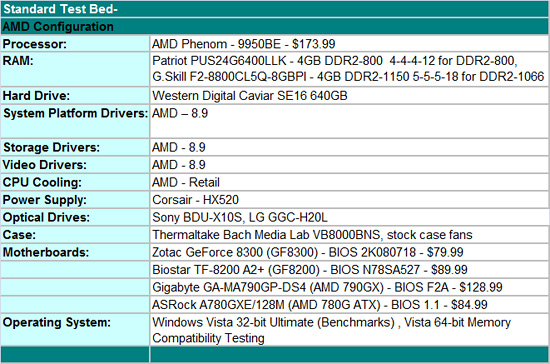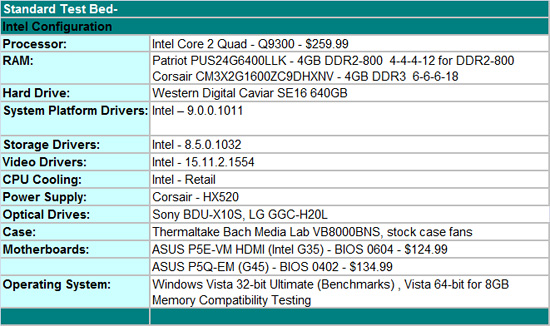The IGP Chronicles Part 2: AMD 780G vs. Intel G45 vs. NVIDIA GeForce 8200
by Gary Key on October 14, 2008 12:40 PM EST- Posted in
- Motherboards
AMD vs. Intel vs. NVIDIA: Fight
At the heart of AMD's 780G we have what AMD is calling a Radeon HD 3200 graphics core, providing the most powerful (on paper) integrated graphics on the market today. The table below should shed some light on the balance of power:
| AMD 790GX | AMD 780G | Intel G45 | Intel G35 | NVIDIA GeForce 8300 | NVIDIA GeForce 8200 | |
| Graphics | Radeon HD 3300 | Radeon HD 3200 | GMA X4500 |
GMA X3500 |
GeForce 8300 mGPU | GeForce 8200 mGPU |
| Core Clock | 700MHz | 500MHz | 800MHz | 667MHz | 500MHz Core / 1.5GHz Shader |
500MHz Core / 1.2GHz Shader |
| Shader Processors | 8 (5-way) | 8 (5-way) | 10 |
8 |
8 | 8 |
| Full H.264/VC-1/MPEG-2 HW Decode | Yes | Yes | Yes | No | Yes | Yes |
While Intel's G35, NVIDIA's GeForce 8200, and AMD's 780G all have 8 of what we're calling "SPs" or stream processors, their clock speeds and capabilities vary greatly from one to the next. Intel and NVIDIA are closest in this regard, as each SP has a peak throughput of a single instruction per clock. AMD's architecture is a bit more capable in the sense that each SP can have a maximum throughput of 5 instructions per clock. It gets a bit more complicated as NVIDIA has separate hardware for transcendental operations, which occupy one of the five "slots" in each AMD SP.
If you multiply it all out that gives Intel a throughput of 8 instructions per clock for G35, 10 for G45, 10 for NVIDIA's GeForce 8200 (where two are transcendental operations) and 40 for AMD. In terms of worst case throughput however, AMD falls down to 8 per clock (assuming the compiler can't feed the hardware 4 shader ops + 1 transcendental per SP) as does NVIDIA. This worst case rarely happens, but it is definitely worth noting.
Taking clock speeds into account, Intel really falls behind here. While G45 has a similar instruction throughput to NVIDIA's architecture, it runs its SPs at 800MHz while NVIDIA runs its at 1.4GHz giving NVIDIA a 75% raw performance advantage. AMD's core runs much slower at 500MHz, but the SPs are far more complex, so we end up with the following scenarios:
In the best case for AMD, the 780G is 43% more powerful than the GeForce 8200, but in the worst case NVIDIA's hardware is 1.8x faster than AMD's thanks to the clock speed advantage and AMD's dependency on ILP within an instruction stream. The integrated graphics race then becomes even more variable than how AMD/NVIDIA stack up with discrete GPUs; the swing from an AMD advantage to an NVIDIA advantage is much wilder than what we see with the GeForce GTX 260 vs. Radeon HD 4850.
The Test
Our Intel test bed today features the Q9300 quad-core processor and the AMD/NVIDIA platform features the Phenom X4 9950BE. Both of theses processor offers terrific performance with decent power consumption and thermals for the cost. Our Patriot DDR2-800 Viper 4GB memory kit has served us well for the past few months and we highly recommend it. We chose Corsair for our HX-520W power supply that has served us well in testing a variety of IGP solutions. Our favorite midrange HDD continues to be the Western Digital SE16 640GB that provides the near perfect balance of price, performance, and capacity.
Our motherboard selection represents a small cross section of IGP products based on the Intel G35/45, AMD 780G, and NVIDIA GeForce 8200/8300 products. While we tested over fourteen motherboards for this article, we're using the results from the best of the best for each chipset.












41 Comments
View All Comments
tonyintoronto - Wednesday, October 15, 2008 - link
The issue is the 780G just doesn't work well enough to be used in htpc.. tons of issues with hdcp and different monitors/tv's, still can't decode mpeg2 stream without crashing the display driver, issues with open GL, was a great idea but bad drivers/hardware have done it for me.. now, the 9300 and 9400 looking nice :)Mathos - Tuesday, October 14, 2008 - link
Hmmmmm Actually the power numbers aren't too bad when you take it into context. Q9300 is a 45nm chip, and 9950 is 65nm. Q9300 is 95w TDP rated, but runs much lower actual TDP. While the 9950 is rated 125w TDP. I'd be interested in seeing this test redone once Deneb variants come out. Considering the lesser performance of the Phenom compared to the Penryn, it actually speaks well of both the AMD based chipsets, and shows that the 790GX does a lot to make up for the processor.I'd say AMD/ATI are doing a good job on the Chipset front now.
Calin - Tuesday, October 14, 2008 - link
Also, considering we're talking about a $174 versus a $260 processor. I wonder what the results were if the comparation would have been against the quad core Q6600 (at a somewhat similar price of $189).3DoubleD - Tuesday, October 14, 2008 - link
"However, they are offering 8-channel LPCM support on the HD 4xxx series of video cards. Of course that option comes with an additional cost and potential problems such as incompatibility with AVR receivers such as those from Yamaha"Can you elaborate on these problems? I was planning on building an HTPC system and was considering this exact combination. Are these temporary (driver update solvable) problems?
This second question is only distantly related to this article. When using the HDMI with LPCM audio, will sound from sources other than Blu-ray discs (such as games or movies with DD5.1 or DTS) be playable on your stereo? Part of me wants to say yes it will for DTS and DD5.1, but I'm skeptical about video games for some reason. I guess I don't fully understand the extent of the sound card capabilities on these IGP/discrete graphics solutions.
Great article, I'm looking forward to your HTPC graphics card review.
AmdInside - Tuesday, October 14, 2008 - link
I own the Asus M3N-H/HDMI (Geforce 8300) and except for the fact that it doesn't have an eSATA port, I have no complaints (well, maybe the placement of the 24-pin power connector).http://www.asus.com/products.aspx?modelmenu=1&...">http://www.asus.com/products.aspx?model...mp;l1=3&...
I recently purchased the Intel G45 Mini-ITX motherboard to build a second HTPC and although it has worked ok for the most part, BD and HD-DVD playback just doesn't seem as smooth as the Geforce 8300. It is not choppy. It just feels like the framerate is lower. I can't explain why. The same HDTV was used with both systems and they were both set to 1080p/60. Both systems are running Windows Vista. If you are building a new HTPC, I would not recommend Windows XP btw with these platforms. Anyways, I appreciated the article. For me, I was trying to build a somewhat portable HTPC with the Intel mini-ITX motherboard but given the problems I am having with BD and HD-DVD playback, I think I am going to leave it as a Windows Media Center DVR box and use the Geforce 8300 as my main HTPC. For what it's worth, I tested with both WinDVD and Arcsoft TMT.
gipper - Tuesday, October 14, 2008 - link
It sounds to me like you're really recommending that at this time the way to go is to get a cheap Intel chipset motherboard with the cheapest, lowest power 45nm Core2 Duo, and an ATI 4550.But what Intel chipset would give that rock solid platform at the lowest price?
tayhimself - Tuesday, October 14, 2008 - link
Neither AMD nor Nvidia can make a decent chipset. Intel seems to have as many misses as they have hits so they're usually a good bet. Boo hiss to poor QC!Nil Einne - Friday, January 30, 2009 - link
As with others, I have to say this is a piss poor review. I looked at the Part 1 and came across a resonably decent review. Was expecting the same thing here. But what do I come across? You onmly test two quad cores. What idiot buys a quad core for their HTPC? Unless you're transcoding there's absolutely no reason and given the price of HDs nowadays and the fact that some broadcasters are using AVC for their HD content anyway there's only a few people who are going to bother. Even if you are occasionally transcoding, it's questionable of you really need a quad core or it might be better to just stick with a dual. At the very lest you could have tested quad cores and dual cores like you did with the previous review. But you didn't and so have a fairly useless review for 99% of the population. Why did you even bother with gaming anyway? Seriously, how many people game with quad core IGP systems particularly the kind of games you were testing. And how many of those check out Anandtech reviews? Maybe 5 people in the whole world... You may use a quad core IGP for a high load server or a non-3D workstation but not gaming.As it stands, based on your previous review (part 1, i.e. the one with the G35) and your comparison between the G35 and G45 I'm guessing that the 8200 is probably still better when paired with a decent CPU for most HTPC purposes but only barely. Sadly it's just a guess for the reasons I outlined above
Nil Einne - Friday, January 30, 2009 - link
When I said part 1 I meant the "IGP Power Consumption - 780G, GF8200, and G35", got slightly confused. One of the strangest things about this review of course is the 8200 performed so poorly whereas in that review, it was better then the 780G. Has the 780G improved a lot? Is it just the Gigabute 780G was a POS? Who knows, one would have thought the reviewer would have at least co=mmented on if not investigated this but apparently notlisajack - Saturday, January 18, 2020 - link
Although, with MMA corner standards, I wouldn’t be surprised if somebody told her to go out there and do her best despite being completely out(weight)classed by the scale.<a href="https://www.nogibjjgear.com/collections/rash-guard... guards</a>